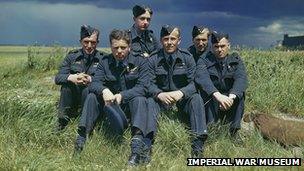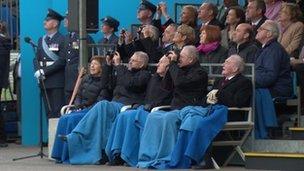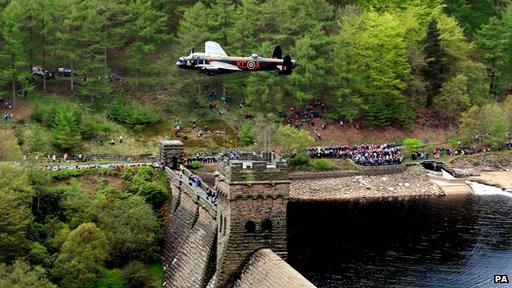Dambusters flypast and ceremony on raid's 70th anniversary
- Published
The Battle of Britain Memorial Flight Lancaster bomber and Spitfire, with Tornadoes from 617 Squadron
Two of the surviving Dambuster airmen have attended a ceremony after a flypast to mark the 70th anniversary of the World War II raid on German dams.
Hundreds of onlookers gathered as a Lancaster bomber flew over Derwent reservoir - one of the practice sites used ahead of the top-secret mission.
More than a third of the men never returned from the raids, when they had to fly just 60ft above ground.
RAF Scampton later hosted a sunset service.
The RAF Battle of Britain Memorial Flight and 617 Squadron flew over the dam in Derbyshire's Hope Valley on Thursday lunchtime.
The ceremony, service and second flypast took place at RAF Scampton in Lincolnshire where, 70 years ago, 19 Lancaster bombers took off for their daring mission.
Only three of the original 133-strong squadron are still alive. Two of them, 94-year-old John "Les" Munro and 91-year-old George "Johnny" Johnson attended the Lincoln service on Thursday evening.
Squadron leader Munro had travelled from New Zealand for the event.
He said he made the 12,000-mile trip "just to renew old acquaintances".
More than 1,300 people were killed in the Dambuster raids when bombs were dropped on German dams and flooded the Ruhr valley.
There were a number of events taking place around the country on Thursday to mark the raids of 16-17 May 1943.

Of the original aircrew, three were captured and 53 were killed
At the National Memorial Arboretum in Alrewas, Staffordshire, more than 10,500 crests with messages of support were planted at the site's Armed Forces Memorial.
Two thousand people turned up to the temporary tribute.
Throughout the day, the RAF was live tweeting, external the original wireless telegraphy signals from the raid, with the final one reading: "06:15 Townsend's Lancaster AJ-O landing at RAF Scampton the last aircraft to return safely. Operation Chastise is over."
On Friday wreaths were laid during a commemoration at the Eder Dam in Germany, which was struck and breached by the bombers.
"I think events like this make us remember the sacrifice those young lads made during the raid", said 66-year-old well-wisher Roy Taylor.

Two of the three surviving Dambusters were at RAF Scampton on Thursday to watch the sunset flyover
"They never got the recognition they deserved I don't think."
The Dambusters raid was carried out by 133 airmen, flying 19 Lancaster bombers armed with the "bouncing bombs" designed by Sir Barnes Wallis.
Dr Wallis's daughter - who attended the service at RAF Scampton - described him as a "man of peace" but said he acted out of a sense of patriotic duty.
"He was not a man of war and that is often not, I think, properly understood," Mary Stopes-Roe told the BBC. "But if you have to defend something you have to defend it and that's it, you do your duty."
He was "devastated" when he heard how many airmen had been lost, she said.

Derwent reservoir was one of the places pilots practised low-flying before the raid
'Very successful'
Compared to today's pilots, who must fly 250ft above ground, they flew incredibly low at 60ft. They also had to fly in the dark for the night-time raids.
They flew so low, according to historian Dan Snow, that one hit the sea, tearing off the bomb carried by the plane. Another flew into high voltage electricity cables and was engulfed in flames.
Codenamed Operation Chastise, 56 of the men who took off on the mission did not return.
Out of 19 bombers, eight were shot down. Three men were captured and 53 were killed.
Eight-year-old Jack Porter, who travelled with his father from Manchester to watch the flypast, said: "I can't believe they flew so low in the dark. They were very brave.
"It was brilliant to see the Lancaster today."
The military impact of the Dambusters raid, immortalised in a 1955 film starring Michael Redgrave, has been disputed.
But Clive Rowley, a former commanding officer of the RAF's Battle of Britain Memorial Flight, said it was an economic disaster for Hitler's Germany.
"In that sense it was truly militarily important, strategically important, and I think that is more modern research that has uncovered that and hasn't been widely recognised until now."
The mission's last surviving pilot, Squadron Leader Munro, told the BBC: "I believe from an operational point of view they were very successful. They had achieved the two major primary targets."
Squadron 617's bombs breached the Mohne and Eder dams, while the Sorpe dam was damaged.
Writing for the BBC news website, Dan Snow said: "No raid mounted by so few aircraft had ever caused such extensive material damage.
"It did not bring German war production to a permanent halt, but nobody had expected it to."
Canadian rear gunner Fred Sutherland, 89, and George Johnson are the only other two surviving members of 617 Squadron.
Of more than 7,000 Lancaster bombers built, only two airworthy planes remain in existence.
- Published16 May 2013
- Published16 May 2013
- Published16 May 2013
- Published16 May 2013
- Published21 March 2013